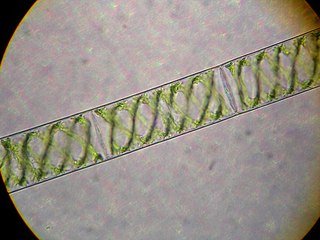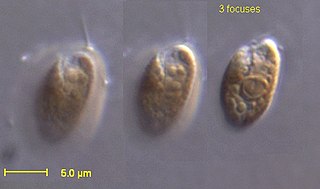
Chlamydomonadales, also known as Volvocales, are an order of flagellated or pseudociliated green algae, specifically of the Chlorophyceae. Chlamydomonadales can form planar or spherical colonies. These vary from Gonium up to Volvox. Each cell has two flagella, and is similar in appearance to Chlamydomonas, with the flagella throughout the colony moving in coordination.
Cryptomonas is the name-giving genus of the Cryptomonads established by German biologist Christian Gottfried Ehrenberg in 1831. The algae are common in freshwater habitats and brackish water worldwide and often form blooms in greater depths of lakes. The cells are usually brownish or greenish in color and are characteristic of having a slit-like furrow at the anterior. They are not known to produce any toxins. They are used to feed small zooplankton, which is the food source for small fish in fish farms. Many species of Cryptomonas can only be identified by DNA sequencing. Cryptomonas can be found in several marine ecosystems in Australia and South Korea.

Spirogyra is a genus of filamentous charophyte green algae of the order Zygnematales, named for the helical or spiral arrangement of the chloroplasts that is characteristic of the genus. Spirogyra species, of which there are more than 400, are commonly found in freshwater habitats. Spirogyra measures approximately 10 to 100 μm in width and may grow to several centimetres in length. It is often observed as green slimy patches on the ground near ponds and other water bodies having stagnant water.

Yellow-green algae or the Xanthophyceae (xanthophytes) are an important group of heterokont algae. Most live in fresh water, but some are found in marine and soil habitats. They vary from single-celled flagellates to simple colonial and filamentous forms. Xanthophyte chloroplasts contain the photosynthetic pigments chlorophyll a, chlorophyll c, β-carotene, and the carotenoid diadinoxanthin. Unlike other Stramenopiles (heterokonts), their chloroplasts do not contain fucoxanthin, which accounts for their lighter colour. Their storage polysaccharide is chrysolaminarin. Xanthophyte cell walls are produced of cellulose and hemicellulose. They appear to be the closest relatives of the brown algae.

The cryptophyceae are a class of algae, most of which have plastids. About 230 species are known, and they are common in freshwater, and also occur in marine and brackish habitats. Each cell is around 10–50 μm in size and flattened in shape, with an anterior groove or pocket. At the edge of the pocket there are typically two slightly unequal flagella.
Protistology is a scientific discipline devoted to the study of protists, a highly diverse group of eukaryotic organisms. All eukaryotes apart from animals, plants and fungi are considered protists. Its field of study therefore overlaps with the more traditional disciplines of phycology, mycology, and protozoology, just as protists embrace mostly unicellular organisms described as algae, some organisms regarded previously as primitive fungi, and protozoa.

Lymnaea is a genus of small to large-sized air-breathing freshwater snails, aquatic pulmonate gastropod mollusks in the subfamily Lymnaeinae ( of the family Lymnaeidae, the pond snails.

Chlamydomonadaceae is a family of algae within the order Chlamydomonadales. Traditionally, it has been defined as containing single-celled flagellates with a cell wall.
Oocystaceae is a family of green algae, in the order Chlorellales. The type genus is Oocystis.

Dinophyceae is a class of dinoflagellates.

Hemiselmis is a genus of cryptomonads.

Scytonema is a genus of photosynthetic cyanobacteria that contains over 100 species. It grows in filaments that form dark mats. Many species are aquatic and are either free-floating or grow attached to a submerged substrate, while others species grow on terrestrial rocks, wood, soil, or plants. Scytonema is a nitrogen fixer, and can provide fixed nitrogen to the leaves of plants on which it is growing. Some species of Scytonema form a symbiotic relationship with fungi to produce a lichen.

Peranema is a genus of free-living phagotrophic euglenids. There are more than 20 nominal species, varying in size between 8 and 200 micrometers. Peranema cells are gliding flagellates found in freshwater lakes, ponds and ditches, and are often abundant at the bottom of stagnant pools rich in decaying organic material. Although they belong to the class Euglenoidea, and are morphologically similar to the green Euglena, Peranema have no chloroplasts, and do not conduct autotrophy. Instead, they capture live prey, such as yeast, bacteria and other flagellates, consuming them with the help of a rigid feeding apparatus called a "rod-organ." Unlike the green euglenids, they lack both an eyespot (stigma), and the paraflagellar body (photoreceptor) that is normally coupled with that organelle. However, while Peranema lack a localized photoreceptor, they do possess the light-sensitive protein rhodopsin, and respond to changes in light with a characteristic "curling behaviour."
Gilbert Morgan Smith was a botanist and phycologist, who worked primarily on the algae. He was best known for his books, particularly the Freshwater Algae of the United States, the Marine Algae of the Monterey Peninsula and the two volumes of Cryptogamic Botany.

Cryptista is a clade of alga-like eukaryotes. It is most likely related to Archaeplastida which includes plants and many algae, within the larger group Diaphoretickes.

Bicosoeca is a genus of bicosoecids in the family Bicosoecaceae.
Petalomonas is a genus of phagotrophic, flagellated euglenoids. Phagotrophic euglenoids are one of the most important forms of flagellates in benthic aquatic systems, playing an important role in microbial food webs. The traits that distinguish this particular genus are highly variable, especially at higher taxa. However, general characteristics such as a rigid cell shape and single emergent flagellum can describe the species among this genus.
Eucapsis is a genus of cyanobacteria belonging to the family Merismopediaceae.

Ochromonas is a genus of algae belonging to the family Chromulinaceae.











